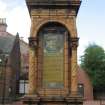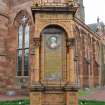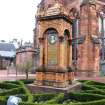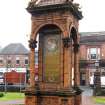Notice
Following a review of the Buildings at Risk Register we have paused the Register while we consider options for its future.
The website will remain accessible and searchable during this time, but it will not be updated and we’re not accepting nominations for additions to the Register. If you need to contact us about the BARR please email hmenquiries@hes.scot
Read the review report here and you can find out more about why we have paused the BARR on our news centre.
Joanna Baillie Monument, Bothwell Parish Church, Bothwell
Ordnance Survey licence number AC0000807262. All rights reserved. © Copyright and database right 2025. Public Sector Viewing Terms
Useful Links
- Canmore:
- BOTHWELL, MAIN STREET, ST BRIDE'S PARISH CHURCH, JOANNE BAILLIE MONUMENT
- Historic Scotland:
- HS Reference No 5135
General Details and Location
Category
AT RISK
Name of Building
Joanna Baillie Monument
Other Name(s)
Address
Bothwell Parish Church, Bothwell
Locality
Postcode
Planning Authority
Divisional Area
Reference No
4703
Listing Category
A
OS Grid Ref
NS 70444 58591
Location Type
Urban
HS Reference No
5135
Description
Square-plan arcaded moulded and cast Italianate monument, raised on polished granite plinth, to the poetess Joanna Baillie, sited to SE of Bothwell Parish Church. Red Doultonware with large, framed mosaic panels to each elevation. Free-standing barleysugar Corinthian column at each angle supporting round arch, standing on advanced square plinths with foliate panels; foliate rectangular panels, slightly recessed, between; cornice between plinth and column. Foliate spandrels; floral and foliate frieze below cornice. Ogee roof with Doultonware blocked tiles and seated cherub at each angle; tall foliate finial. PANELS: roundel with inscription and foliate border below to each elevation depicting portrait of Joanna Baillie, Bothwell Castle, 2 cherubs and fruit trees.
Interest in terracotta peaked in 1886 and a 'rash of terracotta' broke out along high streets and in public places, reflecting a new mood of openness in architectural design, an enthusiasm for new materials and a great sense of civic pride. Producers of terracotta in Scotland numbered only one, being Ferguson, Miller & Co, Heathfield, Strathclyde who produced 'large vases and fountains in the 1850s'. It seems more likely that the Baillie monument was ordered from Doulton & Co, London (or from their works in Rowley Regis, opened in 1889) and assembled on site.
Joanna Baillie was born in the manse behind the church on 11th September 1762 and was the daughter of the minister of St. Brides; she was later to become a friend of Sir Walter Scott. Her father having died in 1776, Joanna and the family moved to London; Joanna spent the rest of her life in Hampstead where she is buried. Here she was to gain notoriety as a poet and a playwright, often writing in her native lowland Scots dialect, her verse "Family Legend" being one of her best known works. The mosaic panels are Venetian, and were manufactured by the Murano Glass Company. The depiction of Joanna is copied from a painting by Masquerier. Likewise, the image of Bothwell Castle with the Clyde at its base is taken from the painting by Horatio McCulloch. (Historic Scotland)
Interest in terracotta peaked in 1886 and a 'rash of terracotta' broke out along high streets and in public places, reflecting a new mood of openness in architectural design, an enthusiasm for new materials and a great sense of civic pride. Producers of terracotta in Scotland numbered only one, being Ferguson, Miller & Co, Heathfield, Strathclyde who produced 'large vases and fountains in the 1850s'. It seems more likely that the Baillie monument was ordered from Doulton & Co, London (or from their works in Rowley Regis, opened in 1889) and assembled on site.
Joanna Baillie was born in the manse behind the church on 11th September 1762 and was the daughter of the minister of St. Brides; she was later to become a friend of Sir Walter Scott. Her father having died in 1776, Joanna and the family moved to London; Joanna spent the rest of her life in Hampstead where she is buried. Here she was to gain notoriety as a poet and a playwright, often writing in her native lowland Scots dialect, her verse "Family Legend" being one of her best known works. The mosaic panels are Venetian, and were manufactured by the Murano Glass Company. The depiction of Joanna is copied from a painting by Masquerier. Likewise, the image of Bothwell Castle with the Clyde at its base is taken from the painting by Horatio McCulloch. (Historic Scotland)
Building Dates
Circa 1899
Architects
Makers possibly Doulton & Co, London
Category of Risk and Development History
Condition
Fair
Category of Risk
High
Exemptions to State of Risk
Field Visits
18/02/2010, 8/7/2013
Development History
February 2010: Inspection finds this fine monument is being prised apart due to failed joints in the roof. Urgent attention is required to prevent significant damage.
8 March 2013: Local planners report no known change at the site.
8 July 2013: External inspection finds no significant change from the previous site visit.
Guides to Development
Conservation Area
Bothwell
Planning Authority Contact
PAC Telephone Number
07551839698
Availability
Current Availability
Not Available
Appointed Agents
Price
Occupancy
Vacant
Occupancy Type
N/A
Present/Former Uses
Name of Owners
Unverified see FAQ on ascertaining ownership
Type of Ownership
Unknown
Information Services
Additional Contacts/Information Source
Bibliography
Online Resources
Classification
Public Monuments
Original Entry Date
14-JUN-10
Date of Last Edit
31/01/2014








